BirdsCaribbean is pleased to announce the 2024 cohort of grantees under two prestigious named awards, the David S. Lee Fund for the Conservation of Caribbean Birds, and the James A. Kushlan Research and Conservation Fund.
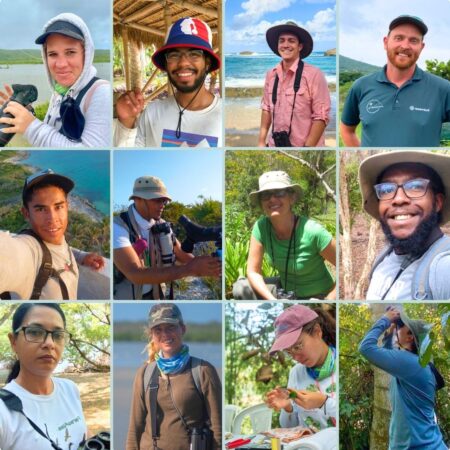 These twelve projects aim to advance the study and conservation of avifauna in seven different Caribbean countries: Cuba, Jamaica, Puerto Rico, Dominican Republic, Mexico (offshore islands in the Caribbean Sea), St. Eustatius, and The Bahamas.
These twelve projects aim to advance the study and conservation of avifauna in seven different Caribbean countries: Cuba, Jamaica, Puerto Rico, Dominican Republic, Mexico (offshore islands in the Caribbean Sea), St. Eustatius, and The Bahamas.
In this article you can read about the exciting plans proposed by each awardee. Stay tuned for results and accomplishments featured in future issues of the Journal of Caribbean Ornithology, blog articles, and presentations at our upcoming 24th BirdsCaribbean International Conference in Dominican Republic this summer.
Congratulations to these outstanding researchers and conservationists from our BirdsCaribbean community!
David S. Lee Fund for the Conservation of Caribbean Birds
Establishing baselines in research, data and science for birds (BiRDS for birds) in The Bahamas
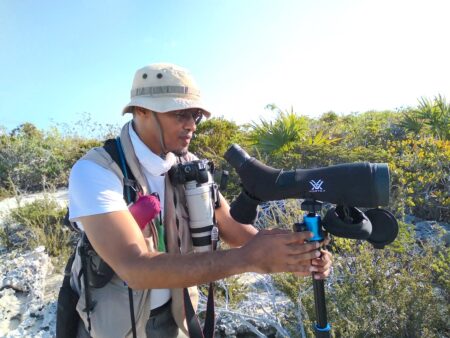 Dr Ancilleno Davis, Science and Perspective & University of The Bahamas
Dr Ancilleno Davis, Science and Perspective & University of The Bahamas
Baselines in Research, Data, and Science for birds (BiRDS for birds) is a program to establish baseline data for bird diversity, population estimates, and research or scientific standards that can be applied to research and conservation activities throughout The Bahamas. The program will provide training in the use of bird monitoring protocols and access to optical equipment to local students along with opportunities to participate in wildlife assessments. It is expected that this project will improve local biodiversity knowledge, and ultimately, will help trainees to have better opportunities for obtaining jobs in conservation in The Bahamas and insular Caribbean.
Distribution shifts of the Oriente Warbler: species assessment in Villa Clara province, Cuba
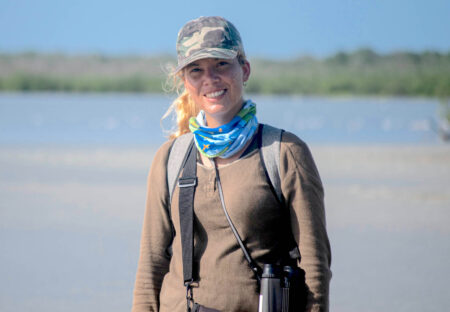 Claudia Mantilla, Center for Environmental Studies and Services of Villa Clara, Cuba
Claudia Mantilla, Center for Environmental Studies and Services of Villa Clara, Cuba
The Oriente Warbler (Teretistris fornsi) is endemic to central-eastern Cuba. In recent years, occasional sightings have been recorded in provinces outside its known range, such as south of Cienfuegos and north of Villa Clara. In this project, Claudia will conduct population surveys and bird banding to understand the species’ distribution in the westernmost part of the central region of the country (Matanzas, Cienfuegos, and Villa Clara), where it also overlaps with the congeneric Yellow-headed Warbler (T. fernandinae). The goal of this study is to determine the ecological requirements of the Oriente Warbler in order to promote the conservation of its habitat, since only 16% of its distribution is within protected areas.
Understanding the importance of a small urban park for conserving migratory and resident bird species in Havana
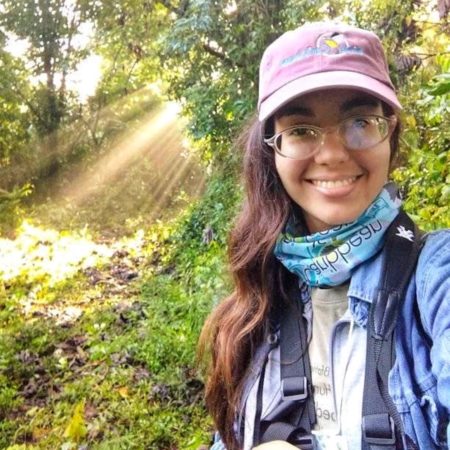 Daniela Ventura, University of Havana, Cuba
Daniela Ventura, University of Havana, Cuba
Havana is home for 47% of the bird species of Cuba, and is an important stopover and wintering site for migratory birds. Research efforts have been conducted in green spaces located in the less densely populated municipalities of the capital. Thus, to obtain a better understanding of urban bird communities within Havana, Daniela plans to expand a banding scheme initiated as part of BirdsCaribbean’s Caribbean Bird Banding Network to the Quinta de Los Molinos Park. Specifically, she intends to evaluate the migration phenology of Neotropical migratory birds that use the site as a stopover or wintering area, and determine the survival and overall physical conditions of migrant and resident bird species. The project will provide an indirect measure of the importance of urban forest fragments for supporting biodiversity, and will increase the awareness of park visitors about the need to protect wild birds.
Raising awareness and education on the endangered Jamaican Blackbird in a National Park
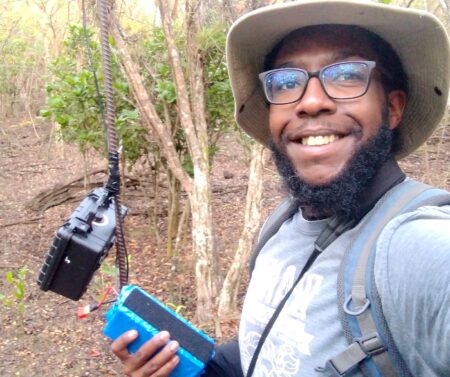 Justin Saunders, BirdLife Jamaica
Justin Saunders, BirdLife Jamaica
In this project, Justin and a team of collaborators from BirdLife Jamaica, aim to create an innovative public education campaign to raise awareness about the endangered Jamaican Blackbird (Nesopsar nigerrimus) and its habitat in the Blue and John Crow Mountains National Park. The project includes the development of educational signs within the park and the creation of a basic virtual tour to engage a broader audience. The educational outcomes will be evaluated at educational events at the park. The plan will be implemented in partnership with the Jamaica Conservation Development Trust, Jamaica Environment Trust, and the National Environment Planning Agency.
Conservation ecology of the Puerto Rican Oriole
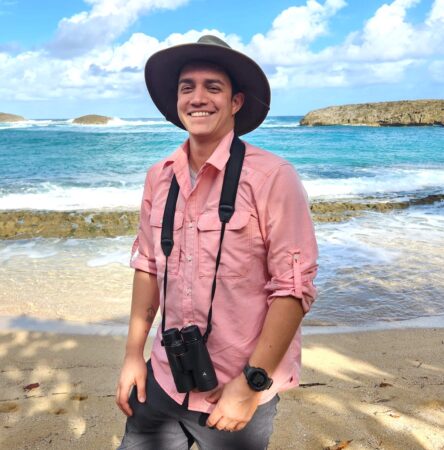 Michael Ocasio, University of Maryland, Baltimore County
Michael Ocasio, University of Maryland, Baltimore County
Conserving Caribbean island endemics, like the Puerto Rican Oriole (Icterus portoricensis), requires an increased and specific understanding of the threats faced by these species. Notably, the Puerto Rican Oriole has shown worrying signs of reproductive challenges, including high rates of brood parasitism and low reproductive success. In this project, Michael aims to assess the oriole’s population dynamics through point counts, banding, radio tracking, and nest monitoring across different habitats and elevations. His results on the species abundance, survival, and reproductive success will contribute to the Puerto Rico State Wildlife Action Plan, the USGS list of Species of Greatest Conservation Need, and the IUCN Red List of Threatened Species, while also fostering collaborative and effective conservation efforts in the Caribbean.
Investigating male and female vocalizations of an understudied endemic Caribbean songbird in Puerto Rico
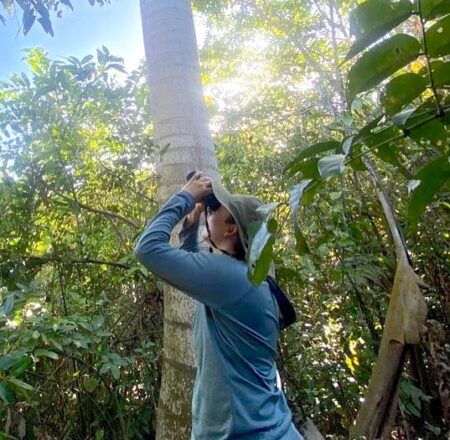 Michelle Moyer, University of Maryland, Baltimore County
Michelle Moyer, University of Maryland, Baltimore County
The Puerto Rican Oriole (Icterus portoricensis), one of 18 endemic species on the island of Puerto Rico, remains significantly understudied. Improving our understanding of how the orioles use sex-specific songs is necessary to develop effective conservation management plans. Preliminary work in 2023 indicated that male and female orioles may sing different songs, but at similar rates. Increasing the sample size by recording additional individuals is crucial for gaining an accurate understanding of the singing behavior of this species. Through this project, Michelle will engage undergraduate students from the University of Puerto Rico in point counts and mist-netting, and intends to co-develop management strategies in collaboration with Para La Naturaleza.
Understanding the social and spatial organization of the Palmchat in the Dominican Republic
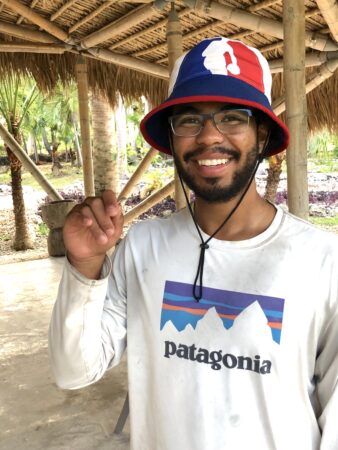 Qwahn Kent, Princeton University
Qwahn Kent, Princeton University
In this project, Qwahn aims to investigate the social and spatial organization of the Palmchat (Dulus dominicus), a communally breeding bird endemic to Hispaniola. The Palmchat plays a crucial role in the ecosystem—it disperses seeds and provides nesting sites for several species, including the critically endangered Ridgway’s Hawk, which nests on top of Palmchat nests. Qwahn will band individual Palmchats and will use a social network analysis to understand their complex organizations. Morphological features of nesting trees will be measured, and a machine learning algorithm will be developed to predict Palmchat nest locations. This research has conservation implications, since the spatial organization of Palmchat nests and their movement patterns influence both patterns of seed dispersal, as well as nest site availability for the hawks.
Help the Bridled Tern return to Isla Contoy National Park, Quintana Roo, Mexico
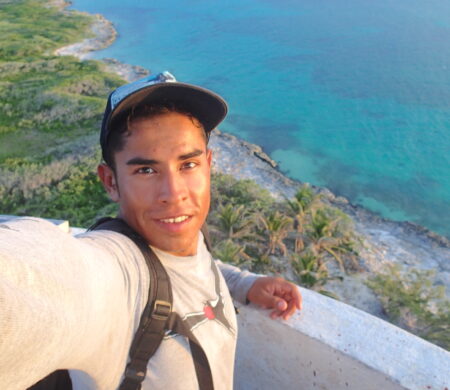 Jonathan Nochebuena, Mexican Association for the Conservation of Birds and their Habitats (AMCAH)
Jonathan Nochebuena, Mexican Association for the Conservation of Birds and their Habitats (AMCAH)
The Bridled Tern (Onychoprion anaethetus) breeds on Isla Contoy, a small Island off the Caribbean coast of Yucatan, Mexico, which is considered a site of international importance for the conservation of seabirds. In 2019, AMCAH started a project to protect the terns’ nesting areas, with the support of park managers and the local group Friends of Isla Contoy. This new project intends to continue the monitoring and banding efforts with community participation, and to develop measures to help increase the species’ population. This initiative will also help raise community awareness about threats to seabirds in general.
James A. Kushlan Research and Conservation Fund
Avifauna of Las Balsas wetland, Gibara, Holguín, Cuba
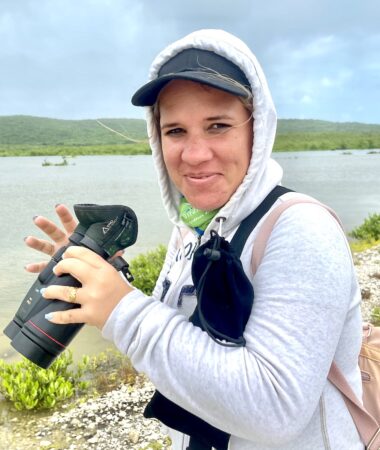 Ailen Anido, Museo de Historia Natural Joaquín Fernández de la Vara, Gibara
Ailen Anido, Museo de Historia Natural Joaquín Fernández de la Vara, Gibara
The wetland Balsas de Gibara in Holguin consists of a large area of mangroves, coastal lagoons, mudflats, and salt marshes located between two rivers that flow into Gibara Bay. High concentrations of waterfowl have been reported in this site, including new bird species for Cuba. Ailen and her team will carry out an inventory of the birdlife of this important site using BirdsCaribbean’s Caribbean Waterbird Census protocols. They will train local residents in bird identification and survey techniques to engage them in the field work throughout the year. She also intends to increase awareness of the high ecological value of this protected area by promoting sustainable practices, such as the creation of a birdwatching club and bolstering bird and nature tourism.
Update of the status and trends of American Flamingos in Cuba
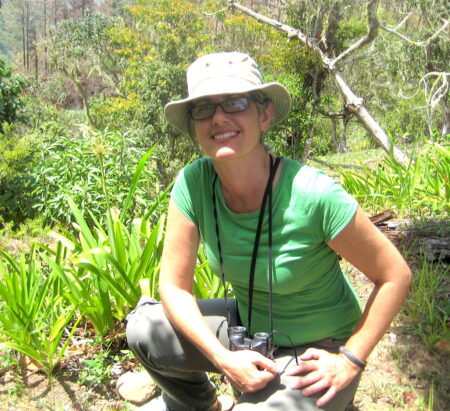 Susana Aguilar, University of Havana
Susana Aguilar, University of Havana
The Cuban population of the American Flamingo (Phoenicopterus ruber), the only flamingo distributed through the Caribbean, is one of the most important in the region. The species depends on estuaries and saline lagoons, making it vulnerable to climate change. In this project, Susana seeks to update the information about the status of the American Flamingo in the island by assessing its current distribution, and estimating its abundance and number of nests in the breeding sites. She and her team will carry out field expeditions to verify new potential nesting sites in remote coastal wetlands of central Cuba, using drones in their surveys. Results are expected to contribute to the improvement of management decisions for the species in Cuba.
Characterization of the community of aquatic birds associated with the wetland of the San Miguel de Parada Fauna Refuge
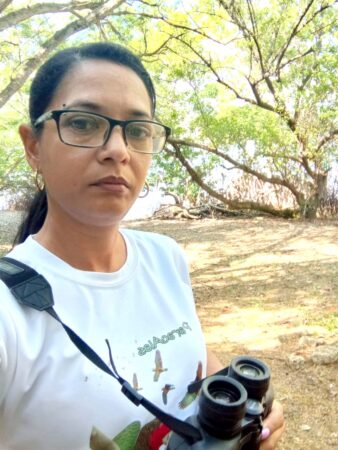 Yanelis Sánchez, Empresa Flora y Fauna, Santiago de Cuba
Yanelis Sánchez, Empresa Flora y Fauna, Santiago de Cuba
Cuban wetlands are important stopover and wintering areas for numerous species of migratory waterbirds. However, they are increasingly being polluted by industrial discharge of solid and liquid waste, like the case of San Miguel de Parada Wildlife Refuge in the province of Santiago, Cuba. Yanelis will be conducting monthly surveys in this wetland throughout the year to determine the composition and structure of the waterfowl community. Moreover, she intends to identify and monitor nesting colonies from May to June, describe their habitat characteristics, and assess the breeding success for different species. As part of the project, she also wants to promote the recovery and conservation of the Santiago de Cuba Bay by implementing effective management actions and educational campaigns.
Enhancing conservation initiatives for Red-billed Tropicbirds in Boven National Park, St. Eustatius
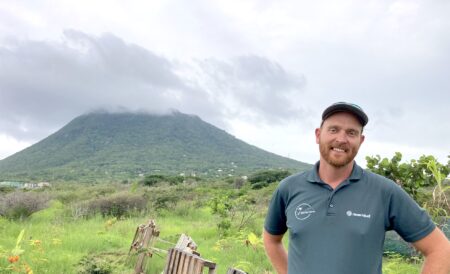 Jethro van’t Hul, St. Eustatius National Parks (STENAPA)
Jethro van’t Hul, St. Eustatius National Parks (STENAPA)
The Red-Billed Tropicbird (Phaethon aethereus), an iconic seabird species with striking red bills and long tail streamers, faces imminent threats to its population on the Caribbean island of St. Eustatius. Previous research estimated only 300-500 breeding pairs. Through this study, Jethro aims to reassess the population on Pilot Hill, and compare counts with a second study site on the cliffside area of Boven National Park where no data has been collected previously. Monthly surveys will be conducted in both locations, and video recordings will be taken to estimate the number of potential nesting pairs in a section of the Boven cliffs. His goal is to obtain a more accurate population estimate of nesting pairs to support further conservation efforts in Boven National Park.
Are you working on, or planning a research or conservation project with Caribbean birds?
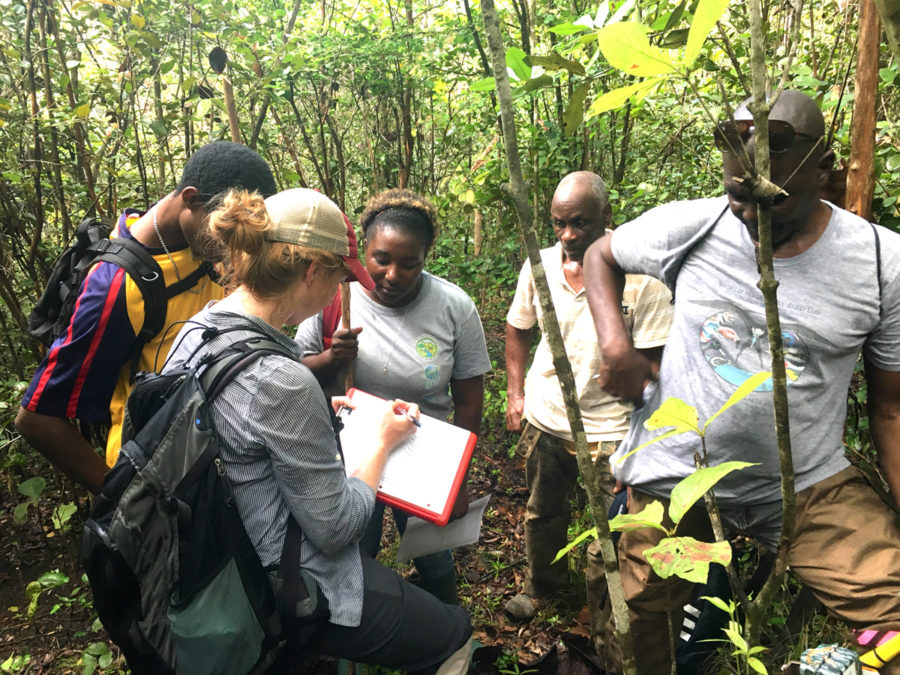
Our next call for proposals will be advertised in the fall of 2024. Members of BirdsCaribbean conducting research and conservation work are eligible to apply. Stay informed and don’t miss our announcements by subscribing to our monthly newsletter, joining our Listserv, and following us on social media (@BirdsCaribbean on Instagram, Facebook, Twitter, Youtube, and Linked In).
BirdsCaribbean thanks our generous donors for supporting these awards, and encourages others to donate to these programs, as well as to consider endowments or other large awards to ensure that our vital grants programs can continue indefinitely. You can help us to continue supporting these invaluable projects by making a donation here.
If you prefer to donate via check, please make this out to “BirdsCaribbean” and in the memo section, note the fund you are donating to. If you have questions, or would like to make other arrangements for donating, feel free to contact Jennifer Wheeler, BirdsCaribbean Financial Officer (jennifer.wheeler@birdscaribbean.org). Checks can be mailed to: BirdsCaribbean, 841 Worcester St. #130, Natick, MA 01760-2076
